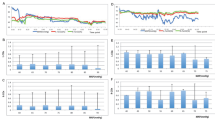Summary
A prospective analysis of 78 patients undergoing coronary artery bypass surgery (CABS) was carried out to assess clinically the frequency and course of cerebral complications during the 1st postoperative week. Detailed evaluation of the patients showed that neurological abnormalities after CABS were common, occurring in 40 of the 78 patients (51%). However, there were no serious cerebral complications. Changes in reflexes and new focal signs were found in 26 and 25 cases respectively; in 7 patients (9%) they were confined to the first postoperative days. There was no statistically significant correlation between postoperative outcome and age, preoperative neurological state or bypass time. However, some strong associations could be calculated between a history of cerebrovascular signs or symptoms and the appearance of persisting focal signs or development reflexes during the 1st week after CABS.
Similar content being viewed by others
References
Aberg T (1988) Cerebral injury during open heart surgery: studies using functional, biochemical, and morphological methods. In: Hilberman M (ed) Brain injury and protection during heart surgery. Martinus Nijhoff, Boston, pp 1–12
Bashein G, Bledsoe SW, Townes BD, Coppel DB (1988) Tools for assessing central nervous system injury in the cardiac surgery patient. In: Hilberman M (ed) Brain injury and protection during heart surgery. Martinus Nijhoff, Boston, pp 109–135
Branthwaite MA (1972) Neurological damage related to openheart surgery. A clinical survey. Thorax 27:748–753
Branthwaite MA (1973) Detection of neurological damage during open-heart surgery. Thorax 28:464–472
Breuer AC, Furlan AJ, Hanson MR, Lederman RJ, Loop FD, Cosgrove DM, Greenstreet RL, Estafanous FG (1983) Central nervous system complications of coronary artery bypass graft surgery: prospective analysis of 421 patients. Stroke 14:682–687
Caplan LR (1980) “Top of the basilar” syndrome. Neurology 30:72–79
Carella F, Travaini G, Contri P, Guzzetti S, Botta M, Pieri E, Mangoni A (1988) Cerebral complications of coronary bypass surgery. A prospective study. Acta Neurol Scand 77:158–163
Coffey CE, Massey EW, Roberts KB, Curtis S, Jones RH, Pryor DB (1983) Natural history of cerebral complications of coronary artery bypass graft surgery. Neurology 33:1416–1421
De Reuck J, Sieben G, De Coster W, Van der Eecken H (1981) Stroke pattern and topography of cerebral infarcts. Eur Neurol 20:411–415
Fisher CM (1982) Lacunar strokes and infarcts: a review. Neurology 32:871–876
Götze P, Dahme B (1980) Psychopathological syndromes and neurological disturbances before and after open-heart surgery. In: Speidel H, Rodewald G (eds) Psychic and neurological dysfunctions after open-heart surgery. Thieme, Stuttgart, pp 48–67
Javid H, Tufo HM, Najafi H, Dye WS, Hunter JA, Julian DC (1969) Neurological abnormalities following open-heart surgery. J Thorac Cardiovasc Surg 58:502–509
Landau WM (1989) Reflex dementia: disinhibited primitive thinking. Neurology 39:133–137
Lienert GA (1971) Die Konfigurationsfrequenzanalyse. I. Ein neuer Weg zu Typen und Syndromen. Z Klin Psych Psychother 19:99–115
Maertens de Noordhout A, Delwaide PJ (1988) The palmomental reflex in Parkinson's disease. Comparisons with normal subjects and clinical relevance. Arch Neurol 45:425–427
Malone M, Prior P, Scholtz CL (1981) Brain damage after cardiopulmonary by-pass: correlations between neurophysiological and neuropathological findings. J Neurol Neurosurg Psychiatry 44:924–931
Meyendorf R (1976) Hirnembolie und Psychose. Unter besonderer Berücksichtigung der Basalganglienapoplexie bei Herzoperationen mit extrakorporaler Zirkulation. J Neurol 213:163–177
Mohr JP (1979) Neurological complications of cardiac valvular disease and cardiac surgery including systemic hypotension. In: Vinken PJ, Bruyn GW (eds) Handbook of clinical neurology, vol 38. North-Holland, Amsterdam, pp 143–171
Nathan PW, Smith MC (1955) The Babinski response: a review and new observations. J Neurol Neurosurg Psychiatry 18:250–259
Sarnquist FH (1988) Neurological outcome after “low flow low pressure” cardiopulmonary bypass. In: Hilberman M (ed) Brain injury and protection during heart surgery. Martinus Nijhoff, Boston, pp 13–25
Shaw PJ, Bates D, Cartlidge N, Heaviside D, Julian D, Shaw D (1985) Early neurological complications of coronary artery bypass surgery. Br Med J 291:1384–1387
Smith PL, Treasure T, Newman SP, Joseph P, Ell PJ, Schneidau A, Harrison MJ (1986) Cerebral consequences of cardiopulmonary bypass. Lancet I:823–825
Sotaniemi KA (1983) Cerebral outcome after extracorporeal circulation. Comparison between prospective and retrospective evaluations. Arch Neurol 40:75–77
Sotaniemi KA, Mononen H, Hokkanen TE (1986) Long-term cerebral outcome after open-heart surgery. A five-year neuropsychological follow-up study. Stroke 17:410–416
Stockard JJ, Bickford RG, Schauble JF (1973) Pressure-dependent cerebral ischemia during cardiopulmonary bypass. Neurology 23:521–529
Toole JF (1984) Cerebrovascular disorders, 3rd edn. Raven Press, New York
Tufo HM, Ostefield AM, Shekelle R (1970) Central nervous system dysfunction following open-heart surgery. JAMA 212:1333–1340
Tweedy J, Reding M, Garcia C, Schulman P, Deutsch G, Antin S (1982) Significance of cortical disinhibition signs. Neurology 32:169–173
Van Gijn J (1978) The Babinski sign and the pyramidal syndrome. J Neurol Neurosurg Psychiatry 41:865–873
Von Eye A (1988) Some multivariate developments in non-parametric statistics. In: Nesselroade JR, Cattell RB (eds) Handbook of multivariate experimental psychology. Plenum Press, New York, pp 367–398
Author information
Authors and Affiliations
Rights and permissions
About this article
Cite this article
Strenge, H., Lindner, V., Paulsen, G. et al. Early neurological abnormalities following coronary artery bypass surgery. Eur Arch Psychiatr Neurol Sci 239, 277–281 (1990). https://doi.org/10.1007/BF01738584
Received:
Issue Date:
DOI: https://doi.org/10.1007/BF01738584



